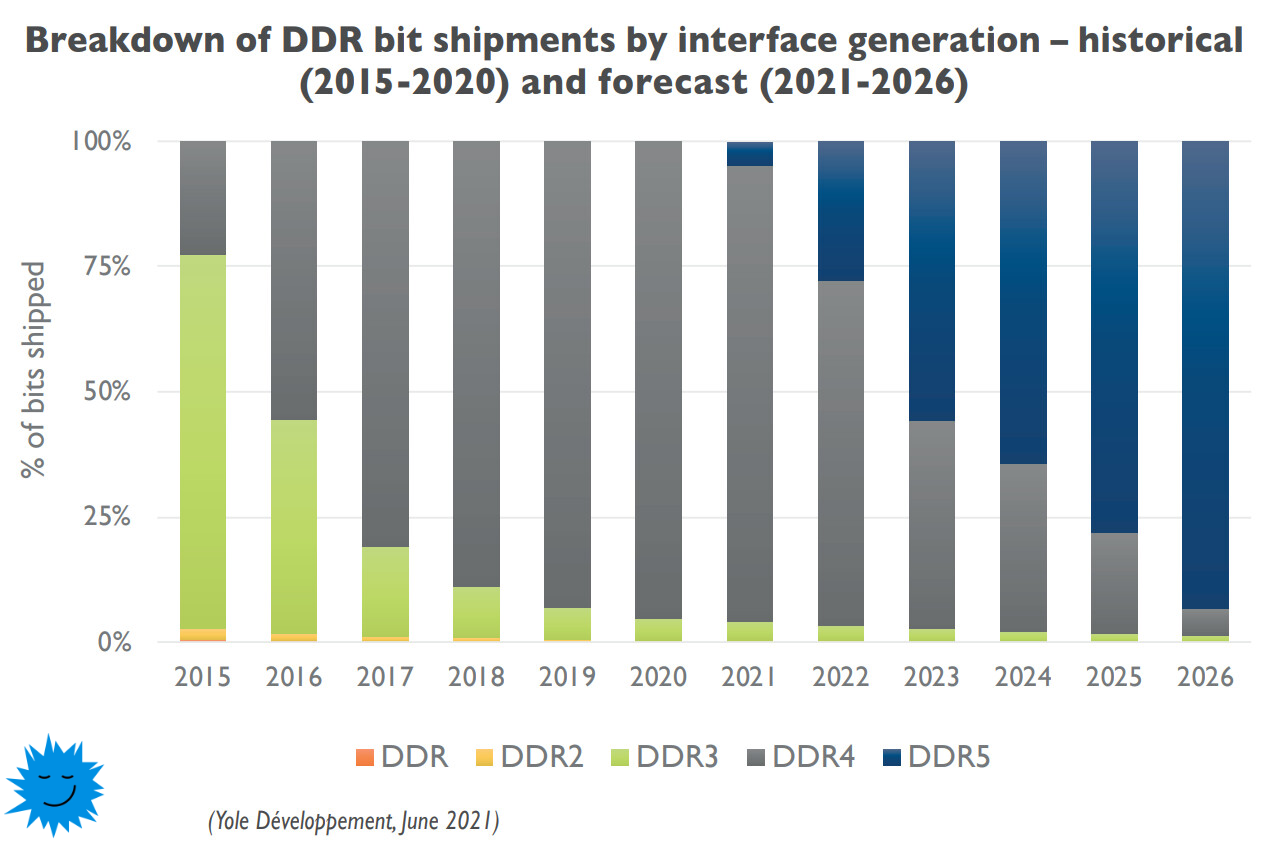
This explosive growth of DDR5 is attributed to several aspects.
First, almost all of the major memory manufacturers have finished developing their products and have already presented the modules to the general public. Some of them have already launched production and will soon begin actively shipping DDR5 memory to everyone.
The second is the dominant position of DDR5 over DDR4. According to the specifications, which were developed by the JEDEC Solid State Technology Association , the starting frequency of the new memory is 4800 Mhz - now this is the upper value for DDR4. In the future, the normal operating frequency of the module at a wide start of DDR5 technology will be 5500-6500 Mhz, up to 8400 Mhz in stock.
The widespread adoption of DDR5 will begin with the release of appropriate motherboards and processors by manufacturers that will be able to work with the new hardware standard.
JEDEC specifications were published just under a year ago - on July 14, 2020. According to the then JEDEC announcement, the DDR5 specification, in comparison with DDR4, supports twice the real channel, up to 6.4 Gbps for DDR5 versus the existing 3.2 Gbps for DDR4.
One of the leaders in this area is the Korean company SK Hynix, one of the oldest and largest manufacturers of RAM chips in the world. Back in late 2020, the Koreans presented the first test memory modules to the public and even then the characteristics were impressive. Then the new memory showed a data transfer rate of 4.8-5.6 Gb / s per contact. That's 1.8 times the baseline of the previous generation DDR4 memory. All this speed is accompanied by a decrease in the base voltage on the memory bar from 1.2 V to 1.1 V.
The new memory will still have 288 pins, that is, in this regard, DDR5 is the successor to the DDR4 standard, but the module pinout itself will be different. The main consumer of new memory in the coming years is considered to be the server segment, primarily data centers. It is for this reason that Intel actively participated in the development of the standard, motherboards and the memory itself, which has occupied a dominant position in the server processor market for many years.

But everything will not be limited only to the server segment. Most likely, the mass launch of DDR5 will occur within one year in both business and consumer segments. Even with the release of the latest custom Ryzen 5xxx processors, AMD officials announced that the next line of Ryzen 6xxx processors, codenamed "Rembrandt" on 6nm Zen 3 Refresh architecture, will come with support for DDR5 memory. In an extreme case, this will happen a little later, after the release of the Zen 4 architecture.
Considering that, at least in Russia, Ryzen processors have consistently dominated the top sales for the last year (the first 4 out of 5 lines on Yandex.Market are almost always occupied by AMD processors) , you can expect a massive transition of users to both Ryzen 6xxx and new memory.

This forecast is especially relevant in light of the current crisis of semiconductor products and computer components, due to which many users have postponed platform upgrades until better times and missed the current generation of processors and video cards. AMD's new processors are slated for release in late 2021 or early 2022.
Intel is also not going to give up positions. Previously, it was planned that the "blue" processors with support for DDR5 will hit the market in 2021 along with the Tiger Lake-H family, but the release was postponed for a year: the first stones capable of working with DDR5 will be released on the Alder Lake architecture in 2022.
The volumes of new modules are also important. The minimum plank size of the new standard is 16 Gb, which should satisfy the demand for more and more memory capacity not only in the server segment, but also in the user segment. Now it is 16 Gb that is an acceptable minimum for home stations or powerful laptops. According to the JEDEC specification, the maximum size of a DDR5 memory stick will be 256 Gb.
Upgrading your server infrastructure is not the fastest process. However, against the backdrop of growing demand for data center capacities and the development of cloud technologies, the forecast of analysts at Yole Developments may turn out to be true. It is believed that the data center market is now at its peak. The top three players in this market, Amazon, Google and Microsoft, are actively investing in the development of their cloud technologies, and private data centers that provide hosting services to businesses are not lagging behind them.
In 2021, a new trend has emerged - data centers from Nvidia for cloud computing. According to Nvidia's plan, their datacenters will include GPUs, data processing units (DPUs) and processors, with each product line receiving an architecture update every two years. The market is witnessing an increase in the popularity of new processors and a shift from old Intel "horses" to new equipment, including the emergence of a market share for new AMD EPYCs . This whole farm will need a new fast memory.
This is what will ensure the growth of the DDR5 market and will quickly lead it to a dominant position in the next three to five years.
Advertising
Our company offers servers for rent with modern processors from Intel and AMD for a variety of tasks. The maximum configuration is 128 CPU cores, 512 GB RAM, 4000 GB NVMe. Create your own rate yourself in a couple of clicks!
Subscribe to our chat on Telegram .
